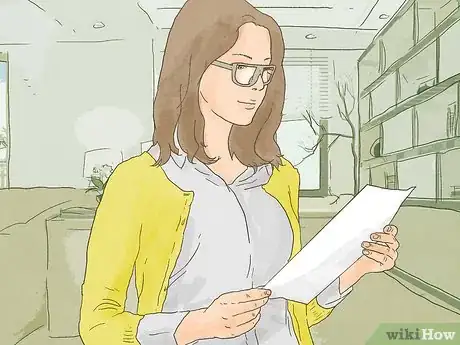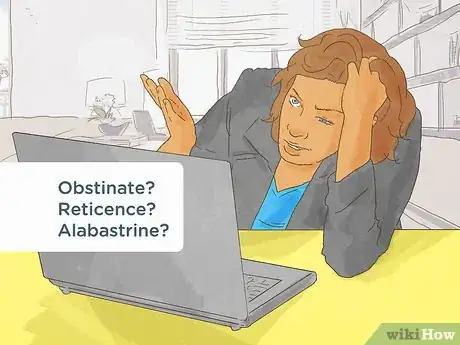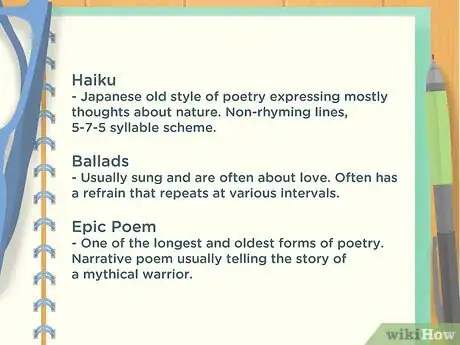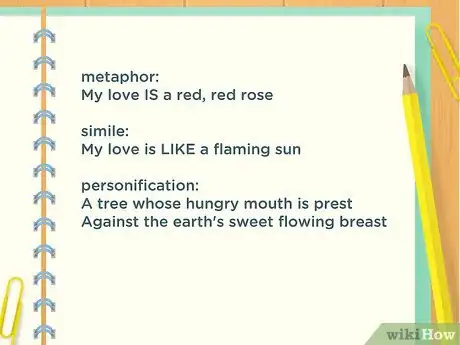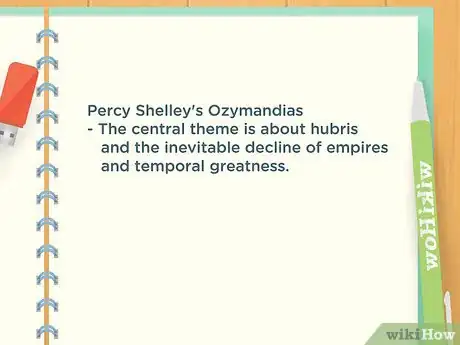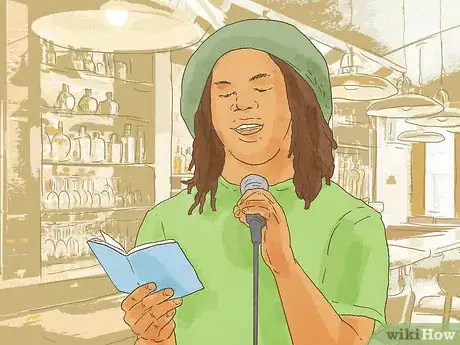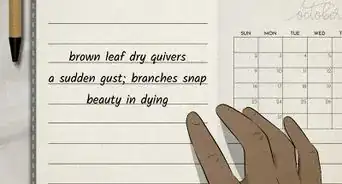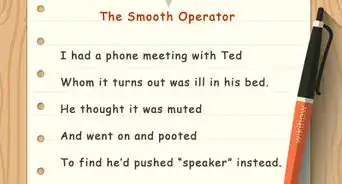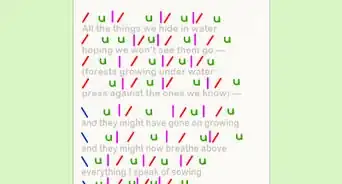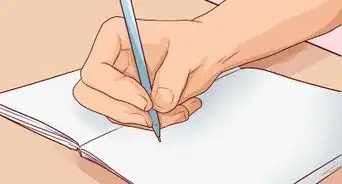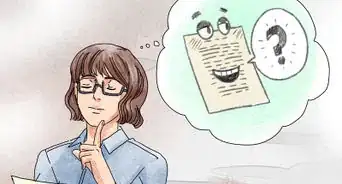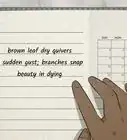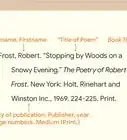This article was co-authored by Stephanie Wong Ken, MFA. Stephanie Wong Ken is a writer based in Canada. Stephanie's writing has appeared in Joyland, Catapult, Pithead Chapel, Cosmonaut's Avenue, and other publications. She holds an MFA in Fiction and Creative Writing from Portland State University.
This article has been viewed 86,761 times.
As someone new to poetry, it may be difficult for you to fully appreciate it as an artform. Though poetry may seem stuffy, confusing, and obscure, it can actually be a great way to see the world from a different perspective. Reading poems for pleasure and experiencing poems by reading, watching, and listening can help you connect with them. You can also analyze poems to deepen your understanding and share them with others so you can discuss them in detail.
Steps
Reading for Pleasure
-
1Read the poem several times. Doing just 1 reading of the poem may not be enough for you to appreciate it. Try reading it at least 2-3 times, taking breaks between each reading. You may find you have a deeper connection to the poem on the second or third, or even fourth read.[1]
- You can also try reading the poem once, putting it aside for a day, and then returning to it for a second or third read. This can give you time to think about the poem in more detail.
-
2Return to lines or words you find pleasing. If any lines or words catch your attention or spark your interest, go back and reread them. Consider why you find the lines or words pleasing.[2]
- For example, you may simply like them or feel you can relate to them. Or you may find the lines interesting because they are strange and unexpected.
Advertisement -
3Close your eyes and picture the images in the poem. Read a line that contains an image or feeling in the poem. Then, close your eyes and try to picture what it might look like to you.[3]
- For example, you may close your eyes and picture an image of a ship on a harbor as it is described in the poem.
Analyzing Poems
-
1Make notes in the margins of the poem. Start by doing a first read of the poem where you take each word as they appear on the page. Write a note in the margins next to any words or phrases that feel important or interesting to you. This way, you can analyze them later and consider what they might mean in the context of the poem.
- For example, you may highlight words like “bandaged,” “fright,” and “goblin” in a poem because they stand out to you.
-
2Look up words you don’t recognize. Use a dictionary to search for words that you are unfamiliar with in the poem. Then, think about how the meaning of the word adds to the lines of the poem. This can help you better understand what the speaker in the poem is trying to say or convey.[4]
-
3Identify the form of the poem. The form of the poem can be free-verse, haiku, sonnet, limerick, tanka, or sestina. Often the poet will choose a particular form to add to the poem’s meaning or to give the poem a certain style. The form can also help you determine the structure and meter of the poem.
- You may need to look up a few examples of different poetic forms to help you identify which one the poem uses. Most modern poems use free-verse, while older poems tend to use more formal structures like the sonnet, haiku, or limerick.
-
4Notice if the poem has a certain rhythm or flow when read aloud. Listen to how the poem sounds when you read it aloud. Pay attention to the rhythm of each line and how each line flows into one another. Think about how the sound of the poem makes you feel. Consider how the rhythm or flow of the poem adds to the overall meaning.
- For example, you may consider questions like, “Does the poem sound smooth and light when read aloud?” “Does it have a choppy or short rhythm?” “Is the poem easy to read aloud or do you have to pause between each line?”
-
5Check for repetition and rhyme in the poem. Poets will use repetition, where the same word or phrase is repeated more than once, to emphasize it and let readers know it is important. Check for words or phrases that are repeated in the poem and consider how they relate to the subject of the poem.
- You can also look at rhyme in the poem to find deeper meaning. Notice if the poem follows a rhyme scheme, where the ends of certain lines rhyme with each other. Think about how the rhymes give the poem structure.
-
6Look for literary devices like metaphor, simile, and personification. A metaphor compares two things to each other. For example, “My love is a red, red rose.” A simile compares two things using “like” or “as.” For example, “My love is like a flaming sun.” Both literary devices are used often in poems to create strong imagery for the reader. They often add sensory details and emotion to the poem.
- Personification is when an inanimate object is given human qualities, such as a tree, a ball, or a computer. It is often used in poems about nature and technology to add deeper meaning to the subject.
-
7Sum up the poem in your own words. Try paraphrasing the poem using your understanding of it. You can be as simple or as complex as you’d like in your summary. Think about how you interpret or understand the poem and try to describe it from your point of view. Keep in mind there is no right answer in poetry, as poems are always up for interpretation.
- For example, you may sum up a poem as a meditation on death and life or a poem as a story about friendship between a boy and his dog.
Experiencing Poems Through Sound and Performance
-
1Read the poem aloud several times. Poems are meant to listened to as well as read on the page. Take the time to read the poem aloud and pay attention to how the words sound. Notice if you connect with particular lines or words in the poem when you read it aloud. Try reading it aloud several times to deepen your understanding of it.
-
2Listen to poets reading their own poems. Another way to make the poem come alive is to try to find a recording of the poet who wrote the poem reading their work. Poets often perform their poems when they read, making them feel more engaging and interesting. Look for recordings of the poem online or through the sound archives at your local library. Many modern poets have recordings of their work that is available for free.
- Try looking for a recording of the poem here: https://www.poetryarchive.org/ or here: https://www.nysoclib.org/collection/poets-reading-poetry.
-
3Go to a live poetry reading in your area. Look for poetry readings at local cafes or bars. Attend open mic nights that feature poetry. Check if a poet you like is performing at a venue in your area and go see them read. Live poetry readings are a great way to experience poetry as entertainment that you watch and listen to.
- You may make it a habit to go to live poetry readings regularly so you are exposed to different poets and their reading styles.
Discussing Poems with Others
-
1Share poems with friends or family for discussion. Sharing poems with others can help you deepen your understanding of them and appreciate them. Choose 1-2 poems that you find interesting, confusing, or engaging. Then, show them to family or friends and ask them what they think. Start a dialogue with those closest to you about the poems and encourage others to share their perspective on the poem.[5]
- For example, you may ask questions like, “What do you think of this poem?” or “Do you like the poem? Why or why not?”
-
2Start a poetry reading group. Another way to broaden your appreciation of poems is to create a reading group where you read and discuss poetry. Ask friends, family, mentors, peers, and partners to join the group. Make the meetings informal and casual so everyone feels comfortable. Print out different poems for discussion and take turns reading the poems aloud.
- You can also ask other members of the group to bring in poems they find interesting or engaging to share.
-
3Engage in discussions about poetry online. There is a growing community of readers and poets who discuss poetry online. Use social media platforms like Twitter or Facebook to find other poets or readers interested in poetry. Look up forums online where people share poems and try to analyze them. Join in the conversation so you can learn how to appreciate poems on a deeper level.
- You can also subscribe to newsletters from poetry magazines and publications so you can discover new poets or poems that you may not have found on your own.
Community Q&A
-
QuestionCant I just write my own poems?
 DonaganTop AnswererOf course. This article is meant for those who are interested in other people's poetry.
DonaganTop AnswererOf course. This article is meant for those who are interested in other people's poetry. -
QuestionHow do I write my first wikiHow?
 DonaganTop AnswererSee Write a New Article on wikiHow and related articles.
DonaganTop AnswererSee Write a New Article on wikiHow and related articles. -
QuestionWhere can I get a sample of an appreciated or analyzed poem?
 DonaganTop AnswererGo here: PoemAnalysis.com.
DonaganTop AnswererGo here: PoemAnalysis.com.
References
- ↑ http://www.english.upenn.edu/~mgamer/Teaching/Handouts/readingpoetry.html
- ↑ http://www.english.upenn.edu/~mgamer/Teaching/Handouts/readingpoetry.html
- ↑ http://www.english.upenn.edu/~mgamer/Teaching/Handouts/readingpoetry.html
- ↑ https://www.highlandhs.org/uploaded/Highland/Academics/Guide_to_Interpreting_Poetry.pdf
- ↑ http://www.writersdigest.com/writing-articles/by-writing-genre/poetry/5_ways_to_share_poetry_with_the_world
